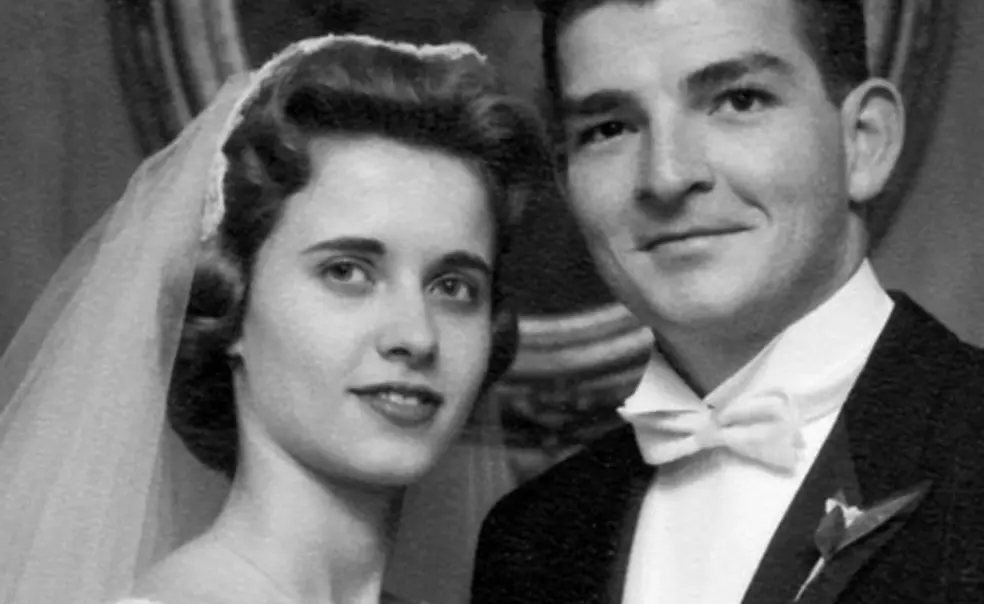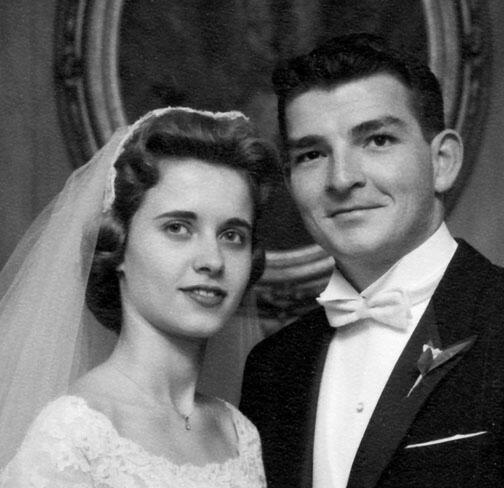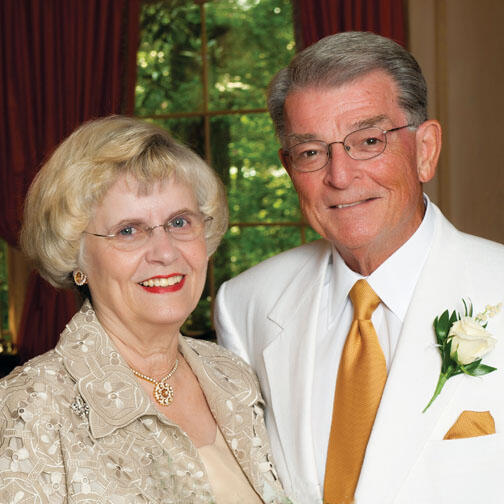Love and marriage may go together like a horse and carriage, as the 1955 hit by song by Sammy Cahn and Jimmy Van Heusen says. But they usually don’t go together with college, too.
Though the number of married undergraduates today is believed to be small, half a century ago, things were different — and in honor of Valentine’s Day, PAW looks back at that time.
From the end of World War II through the early 1960s, it was not unusual for a student to get his marriage license before his diploma. All-male Princeton did not make it easy. The Undergraduate Announcement stated that any student who married while an undergraduate would be compelled to withdraw from the University unless given special permission to remain.
For most young “benedicts” of the time, as they sometimes were called, that meant a trip to Nassau Hall to meet with William Lippincott ’41, the dean of students. As a 1963 PAW article tactfully put it, “The dean does not necessarily disapprove of student marriage as such, but feels this is a valuable time to point out the problems.”
“He could be intimidating, but he was also a nice guy,” recalls John Graham ’61, who faced Lippincott during his junior year. The dean granted permission and explained what he wanted in return: assurances that Graham would not neglect his studies.
Bob Varrin ’56’s visit to see Lippincott — and Dean of the College Jeremiah Finch — was more stressful; he had brought his new bride, Flora, to town before obtaining permission. Finch told Varrin that he probably would have to withdraw, but Lippincott agreed to think it over. Two days later, Varrin was allowed to finish his studies.
As Robert “Hutch” Hutchison ’47 remembers, the biggest problem was not getting permission to marry, but finding a place to live afterward. He entered Princeton in 1944 and married his longtime girlfriend, Betty Ann, the following year. According to a February 1946 article in PAW, 77 of 500 veterans returning to campus were married, bringing with them 30 children. The University created temporary housing for married students in what had been freshman boarding houses on University Place and in Upper and Lower Pyne Halls. Dorm rooms had to be modified for family living. In later years, married undergraduates found places to live around town and in the Butler Apartments (known as the “Barracks”), built in 1947.
The eating clubs remained a focus of social life. Varrin and his wife regularly attended social events at his club, Tower, while Hilton Jervey ’61 and his wife, Georgia, ate at Charter Club on weekends. “I never felt that we were missing out on student life,” Varrin says.
Most of the married Princeton students were supported during their undergraduate years by their wives and parents. The rule, as PAW noted in 1960, was: “He learns, she earns.” The Hutchisons found it impossible to get by on the $90 a month Hutch received under the GI bill, so Betty Ann got a secretarial job on Palmer Square while he held down three part-time jobs. John Graham’s wife, Suzy, taught at Princeton High School. Wives who did not have to work audited classes on campus, formed book clubs, or looked after their young children. Many joined the Wyman Club, a group of graduate-student wives that sponsored, PAW reported, “bridge, arts and crafts, sewing, knitting, and has an excellent group who sing madrigals.”
All say they married because they fell in love and did not want to wait to start building a family. “People didn’t live together [out of wedlock],” Georgia Jervey remembers.
Despite the challenges, the Hutchisons, Grahams, Varrins, and Jerveys saw those years on campus as an adventure. “I was scared at first,” recalls Betty Ann Hutchison, “but I loved Princeton from the minute I got there until graduation.”














4 Responses
Donald W. Maloney ’49
9 Years AgoMarried couples in Brown Hall
In addition to the sites mentioned in the Feb. 9 Alumni Scene story (“Student unions”), the most impressive location for the married couples among the returning veterans in 1946 was Brown Hall, situated as it was in the heart of the campus. I know because the couples were on my mid-evening route on behalf of the Student Sandwich Agency, and when I called out my wares at each entrance opening on the interior courtyard, the young brides would appear quite informally with cash in hand. I was not aware of the Pyne Hall venues.
The so-called Barracks on the site of the polo fields I thought dated from the wartime presence of the Navy. They were still in use for families in 1948, when I was part of the grounds crew mowing the entire campus (I had the hand mower). I was proud to be a paid employee of Princeton after graduating early.
Knox Little ’50
9 Years AgoMarriage requests; expulsion threats
I read “Student Unions” (Alumni Scene, Feb. 9) with personal interest and enjoyment. However, I found the article to be a bit misleading and somewhat incomplete.
I was a 17-year-old high school graduate when, in September of 1946, I came to Princeton as a non-veteran member of the Class of 1950, some 500-plus strong. Chaos reigned for some weeks while the University tried to settle in us “regular freshmen” along with a huge number of returning military veterans of all classes, back to even before 1941. Most of these veterans had been previously admitted. Some had not had the chance to attend or finish even one semester. Others were drafted or enlisted having completed only a few semesters or years; others were from the V-12 programs.
Thus, in the fall of 1946 there were men of all ages and classes starting together. Some were married during the war, and some afterward, in 1945 and early 1946. Many had seen years of bitter combat, and some were disabled. As the article said, the University was not really prepared for returning vets, married or not. It certainly did not have any plan to address the issue that most of the nearly 3,000 students were now men one to five years older than the normal undergraduate would have been in their respective classes.
We were all told that if you got married before you graduated you were out, or “compelled to withdraw,” period. Gradually, during 1946, 1947, and 1948, if you were a veteran with combat or long service experience, and if you wished, you sometimes could persuade the dean to let you get married and stay in school, particularly if you were an upperclassman. Of course, there were some who never told the University they were married, and kept their wives hidden. Most had to wait until after graduation to marry their sweethearts, assuming the girls would wait.
There was the great desire in all of us to settle down, get an education, get married, and have children, all in the shortest period of time, whether we were vets or not. Although we were born in the ’20s, we all were the product of a long, tough Depression, followed by a long, ugly, all-consuming war. Princeton failed to quickly and properly recognize that we and the world had changed.
For the rest of us in the original Class of 1950, there was no hope that the dean, or deans, would agree to a marriage before graduation. I know because I tried many times, as an upperclassman, and always was turned down summarily, even though my marks in aeronautical engineering were 2+ or better.
When I went home for Christmas of 1947, I started to date a young lady I had known since third grade. We often had been in the same class in grammar school, junior high, and high school, even though I ended up going to five different schools in three different towns from 1940 to 1946. By 1946, I had returned to my original hometown and we had graduated together. In 1948 we fell in love.
In the early spring of 1949, we were formally engaged to be married. Although she was able to come down to Princeton on a very few weekends during my upper-class years, staying mostly at Terrace Club, I hitchhiked the 40 miles to my hometown north of Princeton on most other weekends, leaving Friday afternoon and coming back to school Sunday. There was no practical public transportation at all, but sometimes I was able to get a ride with someone I knew. Since you also were kicked out of school if you garaged a car closer to Princeton than your parents’ home, I was able to bring my wife-to-be down myself for only one House Party weekend and at graduation time in 1950. Otherwise she had to get a ride with someone else, or take the train from New York, since she did not have a car.
I was successful in squeezing my classes, studying, and senior research project into mostly a five-day, nearly 80-hour week in my last three semesters.
Even though I attempted to explain to the dean that I probably would get even better marks, be able to participate in more student activities, and it would be safer for both of us if he allowed us to get married in the summer – or at least at Christmastime – of 1949, he hardly would listen to my arguments. I even explained our plan was that she would rent a small apartment well outside of Princeton somewhere near the train line to New York, where she was working weekdays. And/or I would transfer my Model A legally to her name, so she could come by car and pick me up on some weekends. I would continue to room in Southwest with my veteran roommate, but of course, all women had to be out of the dorms by 7 p.m. Again, there was the threat of expulsion.
We eventually were married one week after graduation in June 1950, and left by car for my job in Seattle immediately thereafter. We have been very happily married now for over 60 years, with four children, 10 grandchildren, and one great-grandchild so far. My Princeton education stood me in very good stead for my 35 very-rewarding years at Boeing, as did the one-year, very intensive Sloan Fellowship program at Stanford University Graduate School of Business in 1962. My company paid our way, along with my salary. We lived for one year in Palo Alto in a rented house with four small children. I did very well in the program, although it was hard on the family. I proved to myself that I could be married and do well in a tough university, both at the same time. All of my four children and 10 grandchildren are now successful graduates of universities in the states of Washington or Georgia. None ever applied to Princeton.
In summary, it was not, as you said, “not unusual” for a student to get married from 1946 through at least 1950. Only veterans had an outside chance for permission.
I ended up graduating with 871 others in June 1950, 330 of whom were from other classes. Of the 872 men, 500 were veterans, indicating that at least 50 or so of my original class in 1946 were veterans also. I know of only one original member of my class who was married during our four years. He kept it secret until he had his diploma in hand. Although his wife visited Princeton on some weekends, no one ever guessed!
I do not know what Princeton’s policy on the same subject has been since the 1970s, or is currently, but I assume the issue is largely moot, mores being what they are today.
Bob Louden ’52
9 Years AgoStudents who wed
Re “Student unions” (Alumni Scene, Feb. 9): I married my sweetheart, Anne Zimmerman, during spring break in my senior year in 1952. Anne was a senior at Vassar, and we had dated steadily since we were high school freshmen. When we both turned 21 we sent letters to our parents saying, “We’re getting married, and we hope you’ll come.” They realized that resistance was futile and put together a church wedding for us.
I had my interview with the dean of students and got his permission. At that time World War II veterans at Princeton would not accept the rule that they could not marry, so exceptions were made for them. I was not a veteran, but I had honors standing. I asked the dean why, if you weren’t a veteran, you had to have honors standing to marry. He said, “When we came up with that rule, we believed that anyone smart enough to get honors standing would be smart enough not to try to get married while still an undergraduate!”
At Vassar the rules also forbade undergraduate marriage, but Anne found out that you could marry and wear your wedding ring as long as you didn’t make a big deal about it or get noticeably pregnant, in which case you had to leave. When she told her dean that she wanted to marry, the dean sent her to the Vassar infirmary for contraception information, which was hard to come by in those days.
After our wedding in Cleveland, Anne went back to Vassar and I returned to Princeton. We visited each other on weekends until our graduation. Anne wrote me some 900 letters during our four undergraduate years, one for each day we were apart. Her letters are in the Vassar library so that students today can see what a real romance was like.
Bill Swan ’68
9 Years AgoLiving in the 'Barracks'
I was one of the 30 children who accompanied married soldiers returning to Princeton after World War II. We lived in the “Barracks,” which were built on the old polo fields (“the most fertile ground at Princeton”). I am told I attended my father’s graduation, as he did mine, 20 years later. Dad has died, but mother is still alive, at 86, to tell about it.